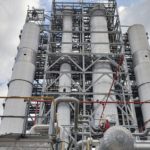Over 6 million tonnes of acrylic acid are produced globally every year, and approximately two-thirds of this volume are ester grade material, while one-third is glacial grade. In effect, acrylic acid monomers with high purity levels are enablers for the production of a wide range of materials for a variety of industries. Technical grade acrylic acid is used for the production of commodity esters, such as surface coatings, adhesives and sealants, plastic additives and paper treatments. Glacial acrylic acid (GAA), is key for the production of superabsorbent polymers (SAPs), which account for almost the entire global GAA demand. These polymers are generally used in liquid-absorbing applications, such as medical dressings, sanitary products and controlled release drugs. The largest SAP segment, however, is the one for baby diapers, which consumes nearly 72 % of the total SAP throughput. GAA plants need to produce materials that achieve or exceed the desired purity level while also minimising energy usage and running costs. So competitive GAA manufacturers regularly invest in new equipment.
Remove impurities
Impurities such as aldehydes, dimers, acetic and propionic acid have certain properties that are very similar to that of acrylic acid, such as boiling points. Hence, distillation methods can be extremely energy demanding. In addition, acrylic acid tends to polymerise at high temperatures. This is an unwanted reaction that manufacturers try to avoid by utilising advanced technologies and following optimum process conditions.
In a recent project, LG Chem, one of the world’s leading manufacturers of acrylic acid and SAPs, was able to leverage state-of-the-art processing technology to produce GAA with concentrations above 99.9 %.
Purification by crystallisation
To enhance its capabilities, the company wanted to increase its ≥99.9 % pure GAA production capacity in its existing manufacturing complex in Yeosu, South Korea
by 145,000 t/a. In order to quickly expand its operations with a new GAA purification unit, the manufacturer contacted its long-term technology partner, Sulzer Chemtech.
The solution developed by Sulzer to purify GAA quickly and efficiently relies on layer crystallisation principles, where crystals
of pure material form and grow onto a cooled surface. More precisely, the setup consists of two falling film crystallisers
and a static crystalliser operating in batches and multi-stage modes. The first two are essential to remove impurities and reach the glacial grade while reducing energy consumption and avoiding the thermal degradation of the product, in this case polymerisation. The last piece of equipment works as a stripping fractionator to maximise acrylic acid recovery, thus increasing product yield.
Cleaning by cooling and heating
The falling film crystallisers consist of a system of vertical tubes that act as heat exchangers. The acrylic acid-rich feed and the heat transfer medium both flow as falling films on the inner and outer surface of the tubes, respectively. In these units, the acrylic acid-rich feed undergoes stages of cooling and heating. First the temperature is lowered below the freezing point of the melt. This causes acrylic acid to crystallise on the surface of the tubes, while impurities remain in the liquid phase. Once all the acrylic acid fraction has been crystallised, the liquid phase is drained from the unit, while the purified crystalline layer remains attached to the plates. This is then further purified by partial melting, also called sweating. This is induced by slightly raising the temperature until the melting point of the crystalline layer is reached. After sweating, the acrylic acid layer is totally melted and collected for further processing, i. e. second falling film crystallisation and static crystallisation.
Within the static crystalliser, a very similar
process occurs. There, cooled plates are
immersed in a stagnant melt, rich in
acrylic acid content. The same stages of crystallisation, draining, sweating and melting take place to enhance the recovery of acrylic acid.
The first falling film crystalliser would allow the manufacturer to obtain a technical grade feedstock with purity higher than 99 %. At the end of the purification train, GAA with acrylic acid content above 99.9 % can be achieved. The combination of falling film and static crystallisation would allow the production of GAA with a yield above 99 %.
Throughout the process, the temperature of the melt is always maintained below 25 °C to retard dimer formation. To succeed in this, Sulzer included a refrigeration unit in its design. This provided the cooling energy for the crystallisation and achieve temperatures below 13.5 °C, the freezing point for acrylic acid.
Installation in one day
Sulzer was able to quickly complete the project, using its global network of specialised facilities to design, manufacture and deliver to LG Chem. All the components were then installed in a record time of a single day. After the assembly of the purification equipment and an initial inspection were carried out, commissioning and start-up were completed within two weeks. This approach ensured that LG Chem could quickly start operating its new unit at full capacity to ramp up its overall production.
Thanks to Sulzer’s proactive approach and expert engineering capabilities, LG Chem was able to expand its operations quickly to meet market demands. In addition, the support provided allowed the manufacturer to immediately produce consistent on-spec GAA, maximizing efficiency in terms of cost, time and energy usage. Finally, the setup provided offers LG Chem a high level of flexibility in its operations. In particular, the company could benefit from a solution that is easy to use and to adjust in order to optimise process conditions throughout all the separation stages.
Sulzer Chemtech Ltd.,
Winterthur, Switzerland








